Working in Russia With Athletes and Children
Blog Content Interviews // March 01, 2018
By Cina Canada
Victoriya Savelyeva is a GYROTONIC® and GYROKINESIS® Master Trainer working in her training center in St. Petersburg, Russia. She teaches children, adults, athletes, and anyone else looking for health and the ability to move better.
I caught up with her in Münstertal, Germany where she was taking a class with Juliu Horvath, creator of the methods. I asked her to share with the community about her work in Russia. There are only a handful of trainers there, but it is a thriving and growing community.
Cina: Let’s start with a bit about your history as an athlete.
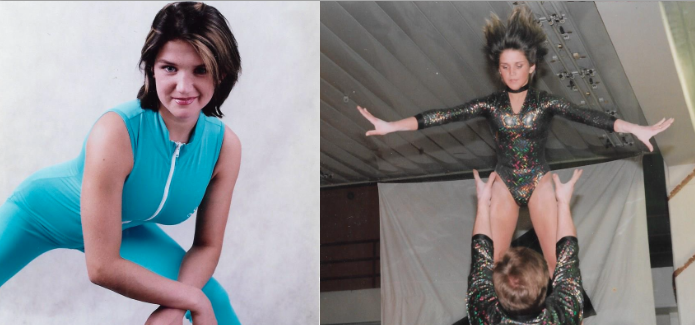
Photo provided by Victoriya Savelyeva
Victoriya: It’s a long story! When I was about six years old I started my sports lifestyle. For me to think about it now is incredible because it’s a really hard job for a child.
First of all, I did gymnastics, which I continued for about ten years. After that, I changed and started acrobatics. I had a partner at that time, and in 1993 we were world champions. We were also first in Russia and other countries. Our last competition was in England when I was 22 years old. By that age, I was considered an old woman, and so I retired from that sport.
After that, I became a sports trainer for children. It was my first job after a life of competition. I soon realized that I needed to continue my athletic lifestyle, so I moved on again to work as an instructor in a fitness club.
Eventually, my acrobatics partner and I decided to open a big health club and fitness center. We did not know anything about the Gyrotonic Method or the Gyrokinesis Method at that time. We just understood that a health center was very important for athletes and also for regular people. It’s very important to maintain your health and to stay in very good condition, so we pursued that.
After starting the fitness club, my business partner had a traffic accident which led to operations. Post surgery, he went for rehabilitation at the Reintal Clinic in Bad Krozingen, Germany. This was more than fifteen years ago. What impressed him the most while at this clinic was how the Gyrotonic work helped him. After his rehabilitation he came back and said, “We need this equipment and we need this work in our club!”
I was the first to go to the Gyrotonic training. I went back to the Reintal Clinic and studied first with Paul Horvath, the brother of Juliu Horvath who is the creator of this work. We bought some Pulley Towers and were the first to bring this work to our big, big country of Russia.
Cina: When you first brought this work to your clients, how did they receive it?
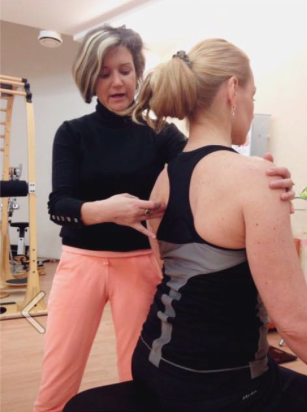
Photo provided by Victoriya Savelyeva
Victoriya: It was different. It was really from person-to-person. We started introducing it to individuals. We needed to have them try it. Only after trying it could they understand that it’s different from other fitness methods.
Now, however, I think there are more and more people who want to find something special because it’s more popular to try new mental and spiritual exercise. It’s not only about exercising this muscle or that muscle. It’s about your whole body, inside your body. When you move your whole body, you can begin to understand your body.
My business partner and I separated and I now have a center in St Petersburg. We mostly have Gyrotonic and Gyrokinesis group classes. We also have individual classes because many of our clients are wealthy and prefer private classes. A lot of our clients were sports people in the past. Many of them have had injuries or operations, but a lot of spine-related issues.
Cina: When people ask you about this work and what it is, how do you explain it?
Victoriya: Usually, I just tell them they need to try it because it’s very difficult to explain. You can’t understand something that you’ve not experienced. For example, if you try to explain the taste of an apple to someone who has never tasted an apple, it would be very hard.
All exercises are generally practiced in two dimensions. With the Gyrotonic work, it’s in three dimensions. You have to feel the difference. The main point is that all of the exercises make sure there is no compression in the spine and joints, while at the same time creating muscle development and joint mobilization with coordination and stretching. You have all of this with the exercises.
Cina: How do you see this work as useful to the high level athlete?
Victoriya: I was a high level athlete and I know how much this system works. For me, for example, I am still an athlete and I have a trainer that works with me for special training in a specific sport. You can’t use anything else during that specific training. For example, with volleyball or basketball, you need specific motor skills for that.
In the Gyrotonic and Gyrokinesis work, you use all of your motor skills. Sometimes this work is more useful for an athlete after specific training because they need rehabilitation and to adapt to a normal lifestyle. I recommend this to all athletes when they finish their sports training. They need to do this because if the body is out of balance in one way, you need symmetrical exercise to rehabilitate the joints that were over-trained.
Cina: How did you come to teach Gyrokinesis for children?
Victoriya: About 20 years ago I became a trainer for children. After I finished my Gyrotonic and Gyrokinesis training, I knew Juliu would like to do something for children because they are really our future and they need to be healthy.
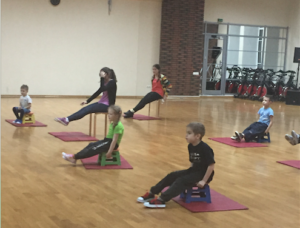
Photo provided by Victoriya Savelyeva
Two or three years ago, I had a children’s group in my center. We were just doing some jumping and stretching and acrobatics, and I had the thought that I could combine my knowledge of acrobatics, working with children, and the Gyrotonic and Gyrokinesis work. I created a program and presented it to Juliu. Then I had a group and some private classes to test it.
Something unique about teaching children is that it requires you to understand that you have two clients: the children and their parents. If the parents don’t like it, the children can’t come. So, you first have to present how it all works to the parents. At the same time, the children have to like it. It’s important to guide parents and children as a team and build those relationships.
I created the first program and thought maybe I could create a poem to help explain all the parts. I found someone who knew how to write poems and he wrote about different animals. Every part has a different story about animals. It’s fun for them because they can see the animals and do the same exercises naturally, even outside in a field or in the forest.
From this, I created the name for the Gyrokinesis program as, “Wonders In the Zoo.” We use different balls and poles to make it more of a game. Often, kids just need relaxation and to play with each other without thinking about exercise. That is why over time I’ve created more fluidity and creativity in the program. But it’s not a game, it’s hard work. They need to listen to you and understand what you are asking of them, and you have to be tolerant.
Cina: How has the Gyrotonic and Gyrokinesis community grown in Russia?
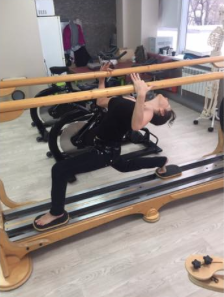
Photo provided by Victoriya Savelyeva
Victoriya: It’s growing, but it’s difficult because it’s hard to explain to people that it’s not just about buying the equipment and then doing some exercises. You have to open your eyes to how it works, to understand how the system works. You’re not just working on a leg or an arm. Your whole body is a system and you have to create the movement for the whole body.
We started more than fifteen years ago, and we started with only four of us. Now we’ve all spread out and are doing different things. We have a lot of places now where you can find Gyrotonic and Gyrokinesis classes in Russia. Just in Moscow, there are five studios. There are also a lot private Pulley Towers in people’s homes. It’s a big, rich city, so people often don’t want to travel to a center; they prefer to have the towers at home and have a trainer come to them. The work is in about six cities. In St. Petersburg, you can find the work in about three health centers and two clinics where they use Pulley Towers for their patients. It is growing and I’m happy about that.
Victoriya now has four fitness centers in Russia that offer the Gyrotonic Method and the Gyrokinesis Method: one center in St. Petersburg, Gyrotonic Academy; and three centers in Moscow: МЦКиТ International Center for Consultation and Training . You can email Victoriya or find more information about her studios at http://gyrotonic-academy.ru.
How is the Gyrotonic and Gyrokinesis community growing in your country? And what are your experiences using the methods to work with children and high-level athletes? Leave a comment and let us know!

Cina Canada is a GYROTONIC® Trainer and the Media Coordinator for GYROTONIC® International Headquarters.
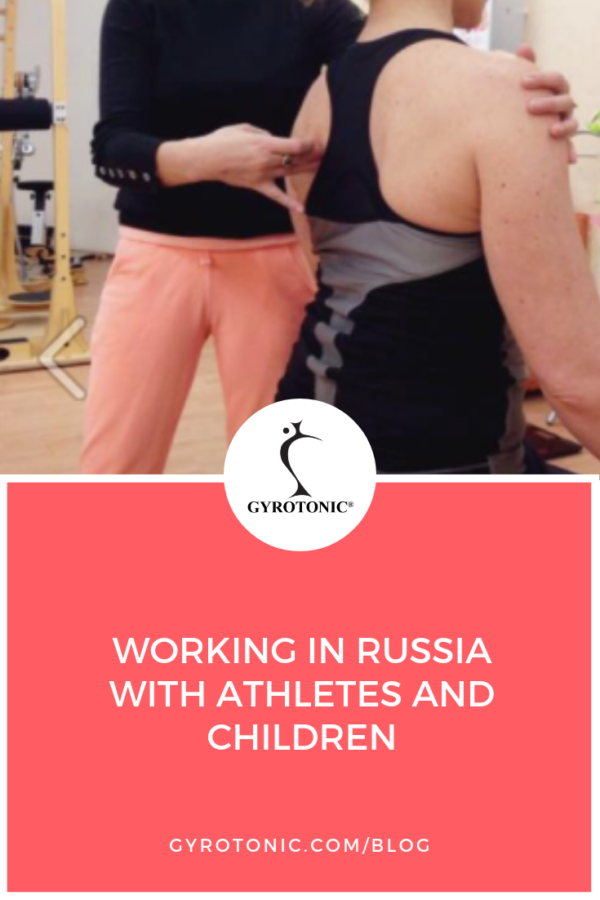
Pin for later!
